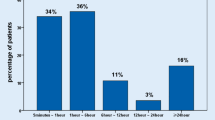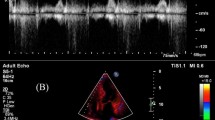Abstract
Aim
The presence of subclinical atrial fibrillation (SCAF) is relevant to issues such as the risk of stroke and the necessity of anticoagulant use in patients with cardiac resynchronization therapy (CRT). Our study aimed to investigate SCAF frequency and associated parameters in patients with CRT.
Methods
One hundred ninety-one patients with CRT (77 females, 114 males, mean age 65.9 ± 9.8) were included in the study. Atrial high-rate episodes detected by the device, atrial electrode impedance, P-wave sense amplitude, and atrial lead threshold values were measured during pacemaker controls. SCAF was defined as asymptomatic atrial high-rate episodes (AHRE) longer than 6 min and shorter than 24 h. Patients were divided into two groups as with and without SCAF.
Results
SCAF was detected in 44 (23.2%) of 191 patients with CRT. Age, sex, weight, aortic end-systolic diameter, left atrium (LA) diameter, left bundle branch block morphology, CHA2DS2-VASc score, and right atrium thresholds were associated with SCAF. In multivariate regression analysis, CHA2DS2-VASc score, LA diameter, and atrial threshold values were found to be independent predictors of SCAF occurrence. According to this analysis, every 1 point increase in CHA2DS2-VASc score, every 1 mm increase in LA diameter, and every 0.1 V increase in atrial threshold increased the risk of SCAF by 32.5, 59.6, and 14.6%, respectively. In the ROC analysis, the area under the curve (AUC) was 0.870, 0.638, and 0,652 for LA diameter, CHA2DS2-VASc score, and atrial lead threshold, respectively (p < 0.05, for all). The cut-off values were 34 mm, 3, and 0.6 V for LA diameter, CHA2DS2-VASc score, and atrial lead threshold, respectively.
Conclusion
Patients with CRT have significantly higher frequency of SCAF than the normal population. CHA2DS2-VASc score, LA diameter, and atrial threshold values were considered to be useful and easily applicable parameters in identifying the patients to develop SCAF.


Similar content being viewed by others
References
Kirchhof P, Benussi S, Kotecha D, Ahlsson A, Atar D, Casadei B, et al. ESC guidelines for the management of atrial fibrillation developed in collaboration with EACTS. Eur Heart J. 2016;37(38):2893–962.
Gorenek B, Bax J, Boriani G, Chen SA, Dagres N, Glotzer TV, et al. Device-detected subclinical atrial tachyarrhythmias: definition, implications and management—an European Heart Rhythm Association (EHRA) consensus document, endorsed by Heart Rhythm Society (HRS), Asia Pacific Heart Rhythm Society (APHRS) and Sociedad Latinoamericana de Estimulacion Cardıaca y Electrofisiologıa (SOLEACE). Europace. 2017;0:1–23. Ehra Consensus Document Published:10 July 2017
Witt CT, Kronborg MB, Nohr EA, Mortensen PT, Gerdes C, Nielsen JC. Early detection of atrial high rate episodes predicts atrial fibrillation and thromboembolic events in patients with cardiac resynchronization therapy. Heart Rhythm. 2015;12(12):2368–75.
Sade LE, Atar I, Özin B, Yüce D, Müderrisoğlu H. Determinants of new-onset atrial fibrillation in patients receiving CRT: mechanistic insights from speckle tracking imaging. JACC Cardiovasc Imaging. 2016;9(2):99–111.
Borleffs CJ, Ypenburg C, van Bommel RJ, Delgado V, van Erven L, Schalij MJ, et al. Clinical importance of new-onset atrial fibrillation after cardiac resynchronization therapy. Heart Rhythm. 2009;6:305–10.
Santini M, Gasparini M, Landolina M, Lunati M, Proclemer A, Padeletti L, et al. Device-detected atrial tachyarrhythmias predict adverse outcome in real-world patients with implantable biventricular defibrillators. J Am Coll Cardiol. 2011;57(2):167–72.
Kannel WB, Wolf PA, Benjamin EJ, Levy D. Prevalence, incidence, prognosis, and predisposing conditions for atrial fibrillation: population-based estimates. Am J Cardiol. 1998;82:2N–9N.
Healey JS, Connolly SJ, Gold MR, Israel CW, Van Gelder IC, Capucci A, et al. ASSERT Investigators. Subclinical atrial fibrillation and the risk of stroke. N Engl J Med. 2012;366:120–9.
Glotzer TV, Daoud EG, Wyse DG, Singer DE, Ezekowitz MD, Hilker C, et al. The relationship between daily atrial tachyarrhythmia burden from implantable device diagnostics and stroke risk: the TRENDS study. Circ Arrhythm Electrophysiol. 2009;2(5):474–80.
Hohnloser SH, Capucci A, Fain E, Gold MR, van Gelder IC, Healey J, et al. ASymptomatic atrial fibrillation and Stroke Evaluation in pacemaker patients and the atrial fibrillation Reduction atrial pacing Trial (ASSERT). Am Heart J. 2006;152:442–7.
Orlov MV, Ghali JK, Araghi-Niknam M, Sherfesee L, Sahr D, Hettrick DA, et al. Asymptomatic atrial fibrillation in pacemaker recipients: incidence, progression, and determinants based on the atrial high rate trial. Pacing Clin Electrophysiol. 2007;30:404–11.
Gillis AM, Morck M. Atrial fibrillation after DDDR pacemaker implantation. J Cardiovasc Electrophysiol. 2002;13:542–7.
Sweeney MO, Hellkamp AS, Ellenbogen KA, Greenspon AJ, Freedman RA, Lee KL, et al. Adverse effect of ventricular pacing on heart failure and atrial fibrillation among patients with normal baseline QRS duration in a clinical trial of pacemaker therapy for sinus node dysfunction. Circulation. 2003;107:2932–7.
Healey JS, Martin JL, Duncan A, Connolly SJ, Ha AH, Morillo CA, et al. Pacemaker-detected atrial fibrillation in patients with pacemakers: prevalence, predictors, and current use of oral anticoagulation. Can J Cardiol. 2013;29(2):224–8.
Cheung JW, Keating RJ, Stein KM, Markowitz SM, Iwai S, Shah BK, et al. Newly detected atrial fibrillation following dual chamber pacemaker implantation. J Cardiovasc Electrophysiol. 2006;17:1323–8.
Abraham WT, Fisher WG, Smith AL, Delurgio DB, Leon AR, Loh E, et al. Cardiac resynchronization in chronic heart failure. N Engl J Med. 2002;346:1845–53.
Cleland JG, Daubert JC, Erdmann E, Freemantle N, Gras D, Kappenberger L, et al. The effect of cardiac resynchronization on morbidity and mortality in heart failure. N Engl J Med. 2005;352:1539–49.
Author information
Authors and Affiliations
Corresponding author
Ethics declarations
The Local Ethics Committee approved the study protocol, and each participant provided written informed consent.
Rights and permissions
About this article
Cite this article
Uğurlu, M., Kaypakli, O., Şahin, D.Y. et al. Subclinical atrial fibrillation frequency and associated parameters in patients with cardiac resynchronization therapy. J Interv Card Electrophysiol 52, 217–223 (2018). https://doi.org/10.1007/s10840-018-0385-4
Received:
Accepted:
Published:
Issue Date:
DOI: https://doi.org/10.1007/s10840-018-0385-4




